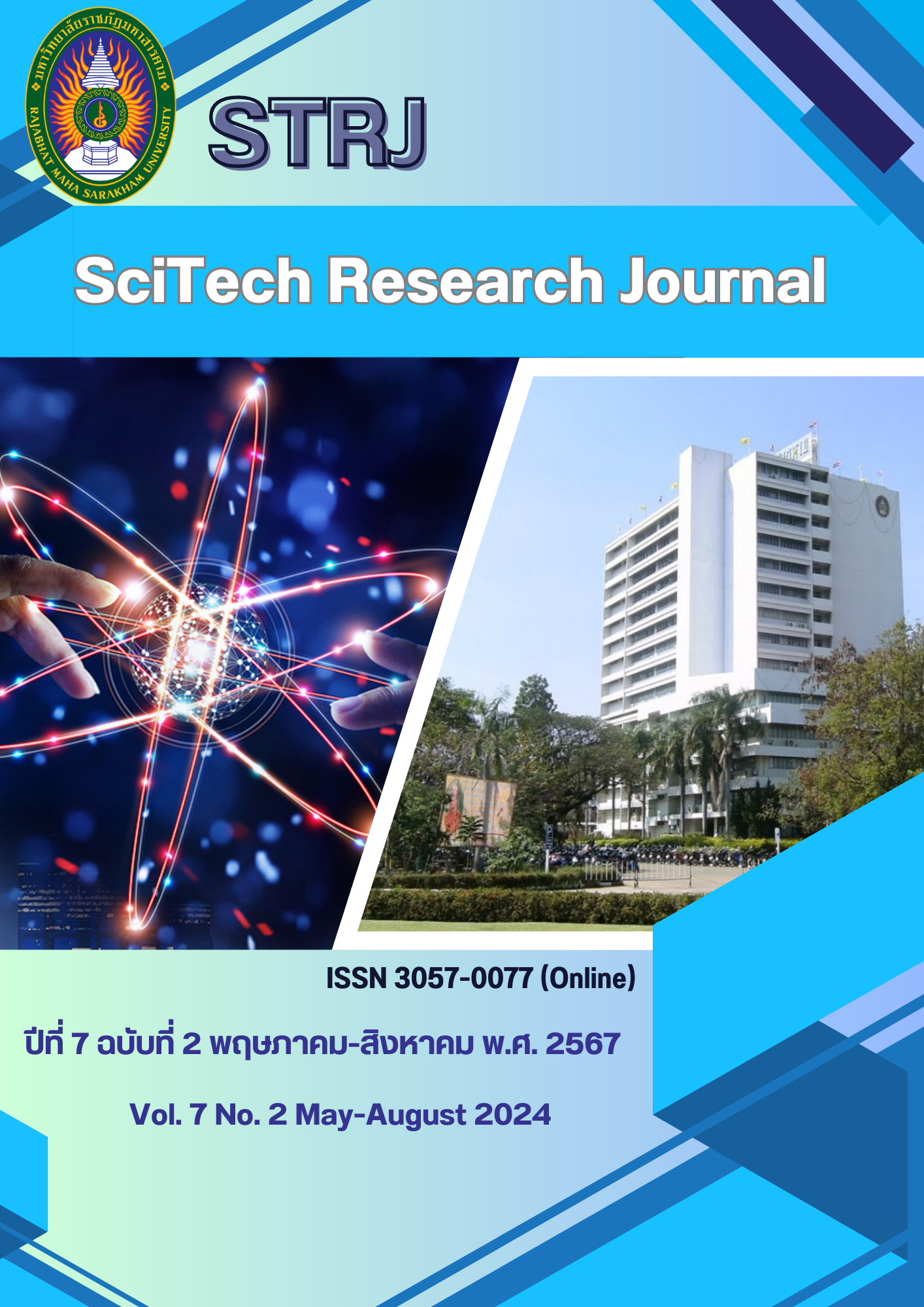Quality Improvement and Green Logistics Potential Assessment of the lump rubber in the Kut Chap District of Udonthani Province
Keywords:
Quality improvement, Green logistics, Lump rubber, Supply chain, SCOR modelAbstract
This research delves into the critical aspects of quality improvement and logistics system in the lump rubber industry, focusing on the Kut Chap District of Udonthani Province. The rubber sector plays a pivotal role in various automotive, construction, and manufacturing industries, underscoring the significance of efficient logistics and quality assurance practices. This study emphasizes the SWOT and SCOR model for continuous improvement in quality development and logistics to drive operational efficiency and competitiveness in the rubber sector. The implementation of ECRS principles led to enhanced efficiency and reduced waste in the manufacturing of lump rubber. This was achieved by streamlining work processes, resulting in a 33% reduction in the number of stages and increased overall quality. The truck, which has a diesel tank capacity of 10.5 liters, releases 27.05 kgCO2e of greenhouse gases per vehicle. This emission is measured to evaluate the capability and readiness of rubber plantations. Green logistics analysis shows potential for efficient logistics and supply chain management, requiring strategic measures like government initiatives and improved production technologies.
References
Agarwal, S., Tyagi, M., & Garg, R. K. (2023). Conception of circular economy obstacles in context of supply chain: a case of rubber industry. International Journal of Productivity and Performance Management, 72(4), 1111-1153. https://doi.org/10.1108/IJPPM-12-2020-0686.
Benzaghta, M. A., Elwalda, A., Mousa, M. M., Erkan, I., & Rahman, M. (2021). SWOT analysis applications: An integrative literature review. Journal of Global Business Insights, 6(1), 54-72.
Chaising, S., & Haasis, H. D. (2021). Cloud computing for logistics and procurement services for SMEs and raw material suppliers. International Journal of Logistics Systems and Management, 38(4), 459-474. https://doi.org/10.1504/IJLSM.2021.114767.
Chanchaichujit, J., Saavedra-Rosas, J., & Kaur, A. (2017). Analysing the impact of restructuring transportation, production and distribution on costs and environment–a case from the Thai Rubber industry. International Journal of Logistics Research and Applications, 20(3), 237-253.
Chehbi-Gamoura, S., Derrouiche, R., Damand, D., & Barth, M. (2020). Insights from big Data Analytics in supply chain management: an all-inclusive literature review using the SCOR model. Production Planning & Control, 31(5), 355-382. https://doi.org/10.1080/09537287.2019.1639839.
Chopra, A., Golwala, D., & Chopra, A. R. (2022). SCOR (Supply Chain Operations Reference) model in textile industry. Journal of Southwest Jiaotong University, 57(1). https://doi.org/10.35741/issn.0258-2724.57.1.33.
De Souza, C. D. R., & Márcio de Almeida, D. A. (2013). Value chain analysis applied to the scrap tire reverse logistics chain: an applied study of co-processing in the cement industry. Resources, Conservation and Recycling, 78, 15-25. https://doi.org/10.1016/j.resconrec.2013.06.007.
Dzwigol, H., Trushkina, N., & Kwilinski, A. (2021). The organizational and economic mechanism of implementing the concept of green logistics. Virtual Economics, 4(2), 41-75.
Herden, T. T. (2020). Explaining the competitive advantage generated from Analytics with the knowledge-based view: the example of Logistics and Supply Chain Management. Business Research, 13(1), 163-214.
Hu, H., Liu, J., Zhu, Q., & Chen, Q. (2021). An integrated supply chain management system for end-of-life tires in China and its promotion barriers: a stakeholder perspective. Resources, conservation and recycling, 164, 105214.
Iqbal, S. M. M., Ireland, C. R., & Rodrigo, V. H. L. (2006). A logistic analysis of the factors determining the decision of smallholder farmers to intercrop: a case study involving rubber–tea intercropping in Sri Lanka. Agricultural Systems, 87(3), 296-312. https://doi.org/10.1016/j.agsy.2005.02.002.
Jansson, J. (2011). Consumer eco‐innovation adoption: assessing attitudinal factors and perceived product characteristics. Business Strategy and the environment, 20(3), 192-210.
Kelendar, H., & Mohammed, M. A. (2020). Lean and the ECRS principle: developing a framework to minimise waste in healthcare sectors. International Journal of Public Health and Clinical Sciences, 7(3), 98-110.
Kritchanchai, D., & Chanpuypetch, W. (2009). A framework for decision support systems in logistics: A case study for Thailand rubber exports. International Journal of Logistics and SCM systems, 3(1), 24-31.
Panoram, P. (2022). THE OPTIMIZATION OF LOGISTICS MANAGEMENT OF THE RUBBER WITHIN BURIRAM OF THAILAND FOR ASEAN. International Journal of Economics and Finance Studies, 14(03), 280-292.
Pawaree, N., Phukapak, S., Puapant, A. & Phukapak, C. (2023). The Spray Dryer Optimization Factor for Yanang Process in small enterprises. Journal of Science and Technology, Rajabhat Maha Sarakham University, 6(1), 88-103.
Pertiwi, A. F. O., & Astuti, R. D. (2020). Increased line efficiency by improved work methods with the ECRS concept in a washing machine production: a case study. Jurnal Sistem dan Manajemen Industri, 4(1), 13-29.
https://doi.org/10.30656/jsmi.v4i1.2184.
Pongsayaporn, P., Chinda, T., & Ammarapala, V. (2020). Key factors influencing multimodal transportation of natural block rubber in Thailand. In MATEC Web of Conference, 312, 02008. EDP Sciences.
https://doi.org/10.1051/matecconf/202031202008.
Puttipipatkajorn, A., & Puttipipatkajorn, A. (2021). Spectroscopic measurement approaches in evaluation of dry rubber content of cup lump rubber using machine learning techniques. International Journal of Agricultural and Biological Engineering, 14(3), 207-213.
Ricardianto, P., Barata, F., Mardiyani, S., Setiawan, E., Subagyo, H., Saribanon, E., & Endri, E. (2022). Supply chain management evaluation in the oil and industry natural gas using SCOR model. Uncertain Supply Chain Management, 10(3), 797-806. http://dx.doi.org/10.5267/j.uscm.2022.4.001.
Rukmayadi, D., Marimin, M., Haris, U., & Yani, M. (2016). Rubber agro-industry green logistic conceptual model. International Journal of Supply Chain Management, 5(3), 192-204.
Vaziri, H. (2023). Investigating the causes of student failure in the 10th physics lesson and the cause and effect diagram of the laboratory with the SWOT matrix.
Wasusri, T., & Chaichomphoo, A. (2008). A study of logistics system for exporting natural rubber from Thailand to China. In 13th International Symposium on Logistics (ISL 2008) Integrating the Global Supply Chain, 6, 277.



